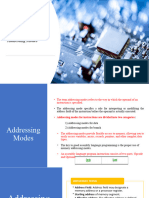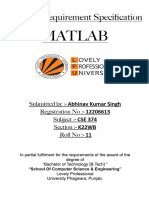CSE211: COMPUTER ORGANIZATION AND DESIGN
Addressing Modes
The term addressing modes refers to how the operand of an instruction is specified. The addressing
mode specifies a rule for interpreting or modifying the address field of the instruction before the
operand is executed. The different ways in which the location of an operand is specified in
instruction are referred to as addressing modes.
1. Addressing Modes Definition
The addressing modes are used to specify the effective address in an instruction. The effective
address contains the object (operand). The object can be a data element or an address that must be
evaluated in the instruction.
2. Why are Addressing Modes Used?
Addressing modes shows the location of a required object in the computer. The object may be an
instruction or data. The output of the addressing mode is an effective address [EA]. The effective
address is the actual address of an object. Therefore we can say the object is equal to the content of
the effective address. The addressing mode is implemented in the instruction in two ways:
• Implicit: The opcode itself specifies the addressing mode used.
Example:- CLA, CLE, CMA, CME etc.
• Explicit: The mode field is used in the instruction format to specify the type of addressing
mode used.
Example:- ADD 2022, ADD 10, STA 2025 etc.
3. Types of Addressing Modes
The addressing modes are categorized into different types:
Implied Mode
Immediate Mode
Register Mode
Register Indirect Mode
Auto-decrement Mode
Auto-increment Mode
Direct Address Mode
Indirect Address Mode
Indexed Addressing Mode
Relative Addressing Mode
Before getting into discussing the addressing modes, one must understand more about the
“effective address” term.
Effective Address (EA):- The effective address refers to the address of an exact memory location in
which an operand’s value is actually present. Let us now explain all of the addressing modes.
Implied Addressing Mode: In the implied mode, the operands are implicitly specified in the
definition of instruction. For instance, the “complement accumulator” instruction refers to an
implied-mode instruction. It is because, in the definition of the instruction, the operand is implied in
the accumulator register. All the register reference instructions are implied-mode instructions that
use an accumulator.
Examples: - CLA, CME, INP etc.
Immediate Addressing Mode: In this mode, the operand is specified in the instruction itself, or we
can say that an immediate mode instruction has an operand rather than an address.
Jhulan Kumar
Assistant Professor
Lovely Professional University (LPU)
� CSE211: COMPUTER ORGANIZATION AND DESIGN
Examples: - ADD 10
Direct Register Addressing Mode: In the register mode, the operands exist in those registers that
reside within a CPU.
Example: - LD R1, ADD R1, R2, ADD R1, R2, R3
Register Indirect Mode: In the register indirect mode, register available in the instruction include the
address of an operand instead of the operand itself.
Example: MOV A, M: means data is transferred from the memory address pointed by the register to
the register A.
The Auto-increment mode: is very similar to the register indirect mode. The only exception is that
the register is incremented after its value is used to access memory. When the address stored in the
register defines a data table in memory.
Example: - LD (R1)+ AC ←M[R1], R1←R1 + 1
The Auto-decrement mode: is very similar to the register indirect mode. The only exception is that
the register is decremented before its value is used to access memory. When the address stored in
the register defines a data table in memory.
Example: - LD -(R1) R1←R1 - 1, AC ← M[R1]
Direct Addressing Mode: In this mode, the address of the memory location that holds the operand is
included in the instruction. The effective address is the address part of the instruction.
Example: LD ADR
Indirect Addressing Mode: In this mode, the address field of the instruction gives the address where
the effective address is stored in memory.
Example: LD @ADR AC←M[M[ADR]] Where: ADR means address like 2020,2021 etc
Relative Addressing Mode: In this mode, the content of the program counter is added to the
address part of the instruction to calculate the effective address.
Example: LD $ADR AC←M[PC + ADR]
Indexed Addressing Mode: In this mode, the effective address will be calculated as the addition of
the content of the index register and the address part of the instruction.
Example: LD ADR(X) AC←M[ADR + XR]
Table 1S Shows example of each addressing mode
Jhulan Kumar
Assistant Professor
Lovely Professional University (LPU)

























































































